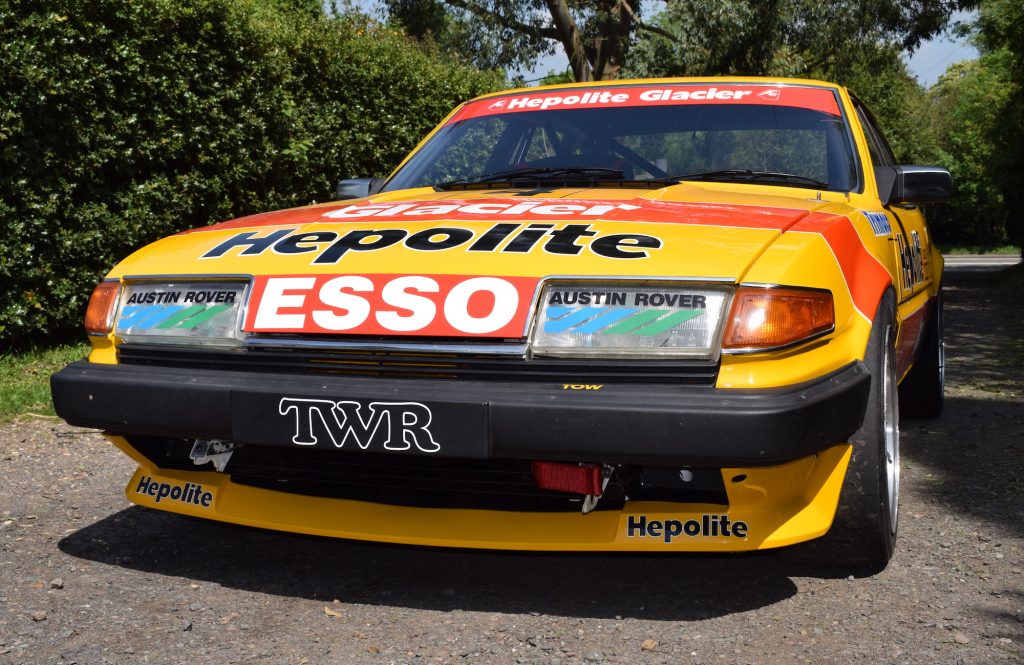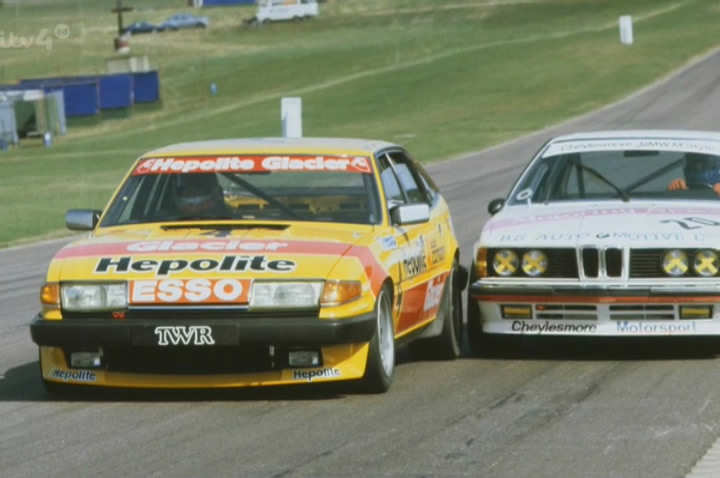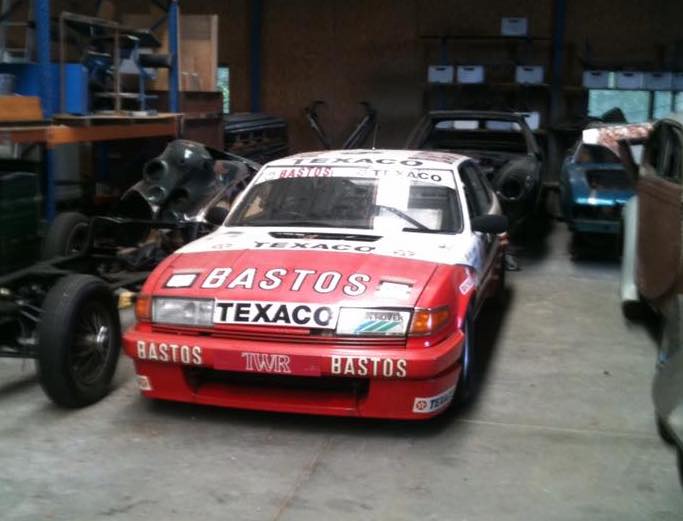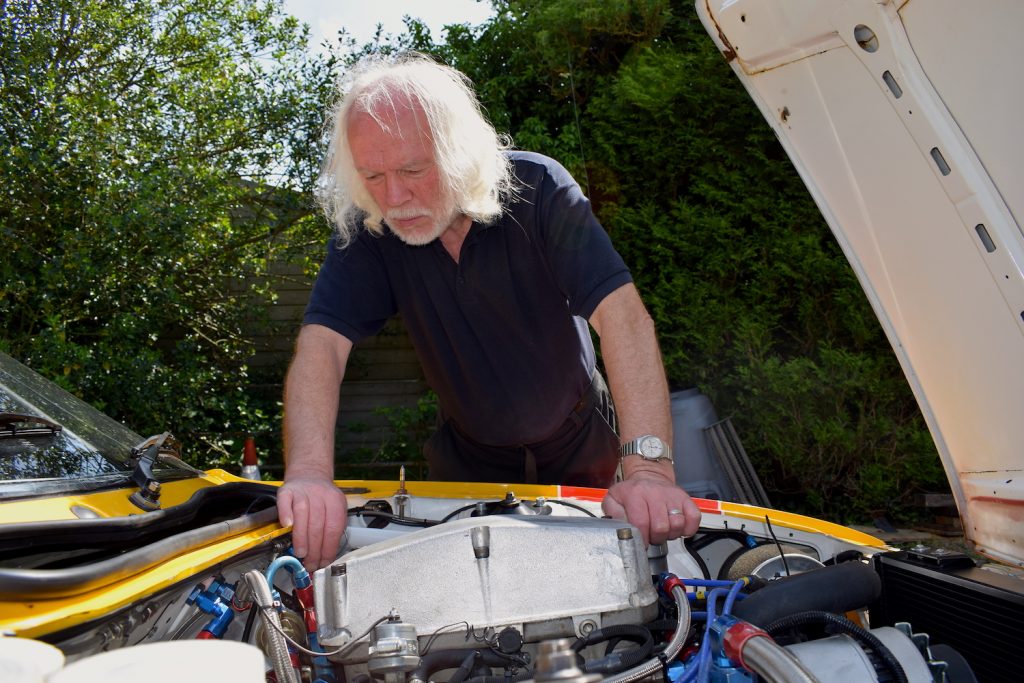"We may have featured a Porsche 993 and an Aston DB7 in this edition, both of which were launched in 1993 - but they would never sell anywhere near as many units as one of the year's more down to earth motor "

“Mr Rover SD1” brings touring car legend back to life
The legendary, and controversial, TWR Rover is back in the hands of the man who built it - and set for the race-track 34 years after it bowed out.
There was to be a lump in Ken Clarke’s throat when he positioned this car onto the grid at Brands Hatch.
Because this wasn’t any old race-car. And for Clarke, this wasn’t any old race. We caught up with him in 2017 just before that race.
–
It’s the emotional culmination of a 34-year motorsport odyssey for man and machine – a now 65-year-old master mechanic and the near-mythical Rover SD1 Vitesse he first built in 1983.
When the lights go green in the Historic Touring Car Challenge, it will represent a lifelong dream for the man dubbed “Mr Rover SD1” – to race the champion car piloted by Steve Soper and controversially disqualified from the ‘83 British Saloon Car championship.

Clarke had been plucked from amateur motorsport by Tom Walkinshaw Racing and charged with building car TWR 002 in little more than six weeks ready for the touring car series’ first season of Group A racing.
He, the car and Soper proved their mettle, winning the title as Rovers dominated the championship, only to have the crown snatched from them months later following protests over regulation breaches from rival Frank Sytner.
Now, after a four-year battle to buy the car from a barn in Holland, then a six-year rebuild, Clarke will finally line up in a car that means more to him than any other.
“It’s a very special car to me,” says Clarke, who now runs his own motorsport business preparing cars for historic racing.
“I thought long and hard about whether to race it. But it’s racing I want to do – I always have done, and if I don’t do it now I never will.
“I’m nervous to put it mildly, because not only is it my car, and my pension, it’s also my business. I can’t afford it to break but I also need it to do well. But if it doesn’t, it’s me, not the car!”
Apart from the brake pads and tyres, the Rover will line up with exactly the same specification and Hepolite livery as 1983, the year Ken Clarke’s life changed forever.

Until then, he had been working as a mechanic at Bill Postins’ performance car garage, helping to build Postins’ mark 2 Ford Escort for the Debenhams Escort Challenge and, later, a series of racing Sciroccos.
But all that was about to change.
“It was Boxing Day and I’d got a week off so I was sitting at home reading Autosport and saw they (TWR) were advertising for a mechanic,” he remembers.
“I got an interview, got the job and started at the end of January. Suddenly I had got to the big time in touring cars from being an amateur race mechanic doing it for beer money. I’d arrived at TWR which, at the time, was the top team in the country to run in touring cars.
“On my first day I went to Cowley and picked up the shell. Then the car went to Gartrac to have a cage fitted, we got it painted and I built the car myself. I had to teach myself ally (aluminium) welding. I had to learn very, very quickly. What I wanted to do was not look stupid – I was working with and against people who had done it for a number of years.”
If learning on the job wasn’t pressure enough, Clarke was in a race against time to get the car ready for the first race at Silverstone on March 20.
Steve Soper was to be the man at the wheel, fresh from piloting a Metro to second in class behind Richard Longman in the ‘82 championship.

“I built the car from scratch in four weeks,” says Clarke, who was 31 at the time. “We tested it before the first race and it went well. It was the first year of Group A, everything was new so we had no parameters, no figures – we didn’t know how fast you had to be. It was a totally blank canvas.”
As it turned out, they were plenty fast enough – Soper powering the 3.5-litre Rover over the line in first place in race one.
“I was over the moon. Steve won five races that year and was declared champion.”
Pete Lovett, with four wins, and Jeff Allam, with two, had completed a TWR Rover clean sweep of all 11 races.
But major controversy was just around the corner, with rival BMW driver Frank Sytner, who had split with TWR the year before, lodging a protest about alleged regulation breaches.
Walkinshaw lodged a counter-protest, ensuring the ultimate destination of the championship would not be decided for more than six months after the last race.

The legal wrangling reached a conclusion when Sytner’s protest was heard by veteran legal counsel Lord Hartley Shawcross, after which the RAC disqualified all the Rover SD1s, handing the title to Andy Rouse in an Alfa GTV6.
“By the time we knew we had not won we were already well into the ‘84 season,” says Clarke.
But Austin Rover were having none of what they saw as inconsistent scrutineering, pulling out of the championship to concentrate on competing in Europe.
As Clarke remembers it, Soper’s car was not protested at all in 1983.
“The team agreed that all the cars were built to the same specification. They found that one was illegal so they were all disqualified,” he says, also taking aim at those in charge of inspecting the cars.
“The scrutineers came along and took the engine to pieces. The Rover had adjustable valve rockers, so they were welded up. They said ‘why have you welded up the rockers? You don’t need to do that’. From then on we didn’t weld them up, so they were adjustable rockers, and they then said you can’t have adjustable rockers.
“Rover pulled out because of the inconsistency of scrutineering.”
It wasn’t just Soper, Rover and TWR who lost out that year – Clarke was stripped of his Mechanic of the Year title before he’d even received it.
“Britool, who were involved in the championship in a minor way, phoned up and wanted to speak to the mechanic. They said ‘congratulations you’ve been awarded mechanic of the year and we want to take you to our dinner in London and give you £1,000’ – then they phoned up three months later and said you’re not having it!”
It was a temporary setback for Clarke, however, who was made chief engineer on the Rovers, focusing on the European series.

Car TWR 002, the fallen champion, was never raced again, spending 1984 on stands in the team’s workshop before new Rover sponsors Bastos requested two show cars – the Hepolite car and its sister, the Marlboro-sponsored TWR 001.
“Car 001 was shown at the British rounds of the European touring car series before going on display at the heritage museum at Gaydon at the end of its life, while mine was repainted in Bastos colours and shipped off to be an Austin Rover show car attending race meetings across Europe at Spa, Nurburgring etc. I didn’t see it again after that,” says Clarke, whose workshop in Burbage, Leicestershire, itself resembles an SD1 museum.
That was, until 2007, more than 20 years after it left England.
“I got a phone call from a guy in Holland who said ‘my friend has got a Bastos Rover and doesn’t know what it is – if I put him in touch can you talk to him and tell him what it is?’

“I’m regarded as Mr Rover SD1, which is why the guy came to me. I spoke to him and said ‘you haven’t got a Bastos Rover’. He said ‘how do you know I haven’t?’ They only built five Bastos cars and I know where they all are. He said ‘well, I’ve got a Rover in racing colours…’
“He sent me some pictures. I told him ‘it looks like a Bastos racing Rover, but it isn’t’. From little bits and pieces in the photographs he’d sent I knew it was one of two cars – and from little niceties I put on mine that weren’t on the others, I could tell it was mine.
“I had made a plate for the dash that had TWR 002 inscribed on it – plus little bits on the front and rear of the car. But I didn’t want to give too much away.

“I said ‘do you want to sell it?’ He said it wasn’t for sale and I left it at that.”
Only, Clarke didn’t leave it at that, speaking to the owner each year from 2008 to 2010 and receiving the same answer each time: not for sale.
“Finally, in 2011, he said ‘it is for sale and it’s not for sale – make me an offer and if I don’t like your offer don’t contact me again’,” says Clarke.
“It was just a shell. How much do you offer somebody for a shell? A complete car had just changed hands for £60,000, but I worked out it would cost £67,000 to totally rebuild the car with engine, suspension etc.
“You could not buy a rear axle, a bottom suspension arm etc – so you’d have to find or make them. I had another Rover in my workshop so I could copy bits off it.”
A price was agreed, and Clarke “rushed over and brought it home”.
“There was a lump in my throat when I saw the chassis plate and TWR 002 on the dash. It had been 25 years previously when I was a mere boy I’d last seen it. It’s a very special car to me.
“The only time I ever drove this car was at Oulton Park, second race of the year in 1983. The Rovers finished 1, 2, 3 and parked on the grid. The three mechanics got in the cars and drove round the circuit.”
The car was painted back to its original Hepolite colours in 2012, but the full rebuild had to wait while business projects took precedence and until sufficient funds became available.

One of those projects was the car’s sister, TWR 001, bought by Richard Postins at the end of 2012.
“The two show cars were back together,” says Clarke. “I built Richard’s in 2013 and then got round to mine.
“I committed to having all the bits made. I was looking after three other Rovers so I took them to pieces and had all the bits copied. Mine never got damaged, never got bent, so I knew it was all straight.
“After I’d built Richard’s we went to Mallory Park for testing. I told him to drive it slowly, but within five laps he was going for times. I said ‘I’ve had all the uprights re-cast – I don’t know how good they are, they might break’. His attitude was ‘well, they’re either going to break now or in the race, so let’s test them’. He raced it at Donington and it finished second.”

Clarke was rather more circumspect when testing his own car this week, but reported that it “went well” ahead of its first racing weekend for 34 years.
It’s a moment the man who symbolises racing Rovers more than any other has waited half a lifetime to experience – and as good a reason as any to keep working.
“I’m 65 now but I can’t think of retiring. My pension is my Hepolite Rover and my collection of cars.
“They are my pension but to make them work for me I’d need to sell them, which defeats the object. I want to enjoy them, so I need to carry on working.
“I sometimes think ‘why am I doing this?’ when I’m up at 2am before Goodwood and something goes wrong, but I couldn’t go and service Mrs Smith’s Ford Fiesta.
“Petrol was in my veins when I was born and I was going to be a racing driver. I’ve been racing Dollies (Triumph Dolomites) for 30 years, but now it’s finally time for the SD1 – the first proper touring car and the best Rover ever built.”
The HTCC event forms part of the Masters Brands Hatch Festival, which also features historic F1 racing, pre-66 touring cars and post-war to 1956 sports car racing.
CLICK TO ENLARGE

















